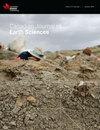怀特霍斯海槽通过碎屑矿物热年代学记录了加拿大北部科迪勒拉地区晚三叠世-白垩纪的增生造山作用
IF 1.6
4区 地球科学
Q3 GEOSCIENCES, MULTIDISCIPLINARY
引用次数: 0
摘要
怀特霍斯海槽形成于早中生代北美西北部山间地体增生时期。利用碎屑矿物热年代学研究了35个样品的171个单晶(U-Th)/He锆石年龄,33个样品的158个单晶(U-Th)/He磷灰石年龄,12个样品的磷灰石裂变径迹年龄。单晶年龄在222 ~ 42 Ma之间,划分了三叠纪—早侏罗世、晚侏罗世和白垩纪—古近纪三个年龄组。AFT中心年龄为95 ~ 30 Ma,主导年龄峰在~50 Ma; AHe单晶年龄为228 ~ 13 Ma,主导年龄峰在50 ~ 40 Ma。热年代学资料的正反演模型与锆石中He含量变化的两个区域埋藏/加热阶段相适应。早侏罗世埋藏并缩短为褶皱冲断带期间,白马海槽局部地层最高温度超过150℃。经过中晚侏罗世发掘相关的降温和突出不整合的发育,白马海槽地层再次被埋藏。白垩纪局部温度超过150°C,表明最大埋藏在~4 ~ 7.5 km之间。早中侏罗世的升温和降温速率为~10°C/myr,与山间地体增生末期的沉积、褶皱和冲断带发育和区域地壳增厚相吻合。白垩纪的最大升温速率为~4 ~ 7°C/myr,可能对应于科迪勒拉北部腹地的区域地壳增厚和外侧安第斯型大陆弧体系的建立。本文章由计算机程序翻译,如有差异,请以英文原文为准。
Whitehorse Trough records Late Triassic-Cretaceous accretionary orogenesis in the Northern Canadian Cordillera via detrital mineral thermochronometry
The Whitehorse Trough formed during early Mesozoic accretion of the Intermontane terranes to northwestern North America. Here we investigate its thermal history using detrital mineral thermochronology, including 171 single-crystal (U-Th)/He zircon (ZHe) ages from 35 samples, 158 single-crystal (U-Th)/He apatite (AHe) ages from 33 samples, and apatite fission track (AFT) ages from 12 samples. ZHe single crystal ages range from 222-42 Ma and define Triassic-Early Jurassic, Late Jurassic, and Cretaceous-Paleogene age groups. AFT central ages range from 95-30 Ma with a dominant age peak at ~50 Ma, and AHe single crystal ages range from 228-13 Ma with a dominant age peak between 50-40 Ma. Forward and inverse models of thermochronological data are compatible with two regional burial/heating stages that variably reset He in zircon. Maximum temperatures of the Whitehorse Trough strata locally exceeded 150 °C during Early Jurassic burial and shortening into a fold and thrust belt. Following Middle to Late Jurassic exhumation-related cooling and development of a prominent unconformity, Whitehorse Trough strata were buried again. Temperatures locally exceeded 150 °C during the Cretaceous, suggesting maximum burial of between ~4 and 7.5 km. Heating and cooling rates during the Early-Middle Jurassic were ~10 °C/myr, coinciding with deposition, fold and thrust belt development and regional crustal thickening during the final stages of Intermontane terrane accretion. Maximum heating rates during the Cretaceous were ~4-7 °C/myr and likely correspond to regional crustal thickening of the northern Cordillera hinterland and establishment of an outboard, Andean-type continental arc system.
求助全文
通过发布文献求助,成功后即可免费获取论文全文。
去求助
来源期刊

Canadian Journal of Earth Sciences
地学-地球科学综合
CiteScore
2.80
自引率
7.10%
发文量
66
审稿时长
6-12 weeks
期刊介绍:
The Canadian Journal of Earth Sciences reports current research in climate and environmental geoscience; geoarchaeology and forensic geoscience; geochronology and geochemistry; geophysics; GIS and geomatics; hydrology; mineralogy and petrology; mining and engineering geology; ore deposits and economic geology; paleontology, petroleum geology and basin analysis; physical geography and Quaternary geoscience; planetary geoscience; sedimentology and stratigraphy; soil sciences; and structural geology and tectonics. It also publishes special issues that focus on information and studies about a particular segment of earth sciences.
 求助内容:
求助内容: 应助结果提醒方式:
应助结果提醒方式:


